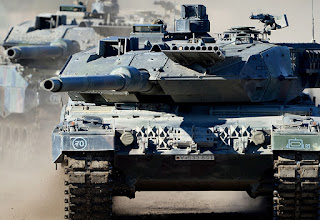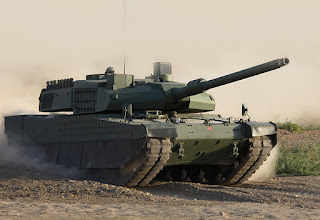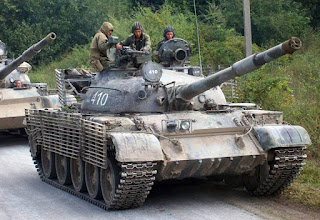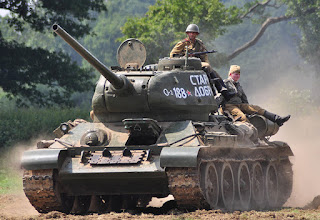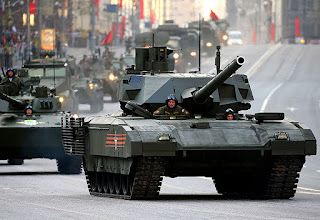Main Battle Tanks
1. M1 Abrams Tank:
The M1 Abrams is an American third-generation main battle tank. It is named after General Creighton Abrams, former Army chief of staff and commander of United States military forces in the Vietnam War from 1968 to 1972. Highly mobile, designed for modern armored ground warfare, the M1 is well armed and heavily armored. Notable features include the use of a powerful multifuel turbine engine, the adoption of sophisticated composite armor, and separate ammunition storage in a blow-out compartment for crew safety. Weighing nearly 68 short tons (almost 62 metric tons), it is one of the heaviest main battle tanks in service. More details
2. Leopard 2 Tank:
The Leopard 2 is a main battle tank developed by Krauss-Maffei in the 1970s for the West German Army. The tank first entered service in 1979 and succeeded the earlier Leopard 1 as the main battle tank of the German Army. Various versions have served in the armed forces of Germany and 12 other European countries, as well as several non-European nations. The Leopard 2 was used in Kosovo with the German Army and has also seen action in Afghanistan with the Danish and Canadian contributions to the International Security Assistance Force, as well as seeing action in Syria with the Turkish Armed Forces against IS and the YPJ. More details
3. Challenger 2 Tank:
The Challenger 2 is a British main battle tank (MBT) in service with the armies of the United Kingdom and Oman. It was designed and built by the British company Vickers Defence Systems (BAE Systems Land & Armaments). Vickers Defence Systems began to develop a successor to Challenger 1 as a private venture in 1986. A £90 million deal for a demonstrator vehicle was finalised in January 1989. In June 1991, the Ministry of Defence placed a £520 million order for 140 vehicles, with a further 268 ordered in 1994. More details
4. K2 Black Panther Tank:
The K2 Black Panther is a South Korean main battle tank that will replace most of the M48 Patton tanks and complement the K1 series of main battle tanks currently fielded by the Republic of Korea. Mass production commenced in 2013 and the first K2s were deployed with the armed forces in June 2014. The K2 costs over US$8.5 million per unit. The first 15 K2 Black Panther tanks were put into service in June 2014. Faulty indigenous engines and transmissions previously halted production, but the lowering of required acceleration performance allowed it to enter service. The "power pack" of tank is intended to be locally developed. More details
5. Merkava MK 4 Tank:
The Merkava is a main battle tank used by the Israel Defense Forces. The tank began development in 1973 and entered official service in 1978. Four main variants of the tank have been deployed. It was first used extensively in the 1982 Lebanon War. The name "Merkava" was derived from the IDF's initial development program name. Design criteria include rapid repair of battle damage, survivability, cost-effectiveness and off-road performance. Following the model of contemporary self-propelled howitzers, the turret assembly is located closer to the rear than in most main battle tanks. More details
6. AMX Leclerc Tank:
The AMX Leclerc is a main battle tank (MBT) built by GIAT, now Nexter of France. It was named in honour of General Philippe Leclerc de Hauteclocque who led the French element of the drive towards Paris while in command of the Free French 2nd Armoured Division in World War II. The Leclerc is in service with the French Army and the army of the United Arab Emirates. In production since 1991, the Leclerc entered French service in 1992, replacing the AMX 30 as the country's main armoured platform. More details
7. T-90 Main Battle Tank:
The T-90 is a third-generation Russian battle tank that entered service in 1993. The tank is a modern variation of the T-72B and incorporates many features found on the T-80U. Originally called the T-72BU, but later renamed to T-90, it is an advanced tank in service with Russian Ground Forces and the Naval Infantry. The T-90 uses a 125 mm 2A46 smoothbore main gun, the 1A45T fire-control system, an upgraded engine, gunner's thermal sight. Standard protective measures include a blend of steel and composite armour, smoke grenade dischargers, Kontakt-5 explosive-reactive armour and the Shtora infrared ATGM jamming system. More details
8. T-72 Main Battle Tank:
The T-72 is a Soviet second-generation main battle tank that entered production in 1971. About 20,000 T-72 tanks were built, making it one of the most widely produced post–World War II tanks, second only to the T-54/55 family. The T-72 was widely exported and saw service in 40 countries and in numerous conflicts. The T-72 shares many design features with other tank designs of Soviet origin. Some of these are viewed as deficiencies in a straight comparison to NATO tanks, but most are a product of the way these tanks were envisioned to be employed, based on the Soviets' practical experiences in World War II. More details
9. Altay Main Battle Tank:
The Altay is a modern main battle tank, based on the South Korean K2 Black Panther tank, developed by Otokar, a subsidiary of Koç Holding, for the Turkish Army and export markets. It is named in honor of Army General Fahrettin Altay who commanded the 5th Cavalry Corps in the final stage of the Turkish War of Independence. In order to improve the current technical capabilities of the Turkish defense industries and increase the amount of domestic contribution towards national defense. More details
10. T-80 Main Battle Tank:
The T-80 is a third-generation main battle tank (MBT) designed and manufactured in the Soviet Union. When it entered service in 1976, it was the first MBT in the world to feature a powerful multifuel turbine engine as its main propulsion engine. The T-80U was last produced in a factory in Omsk, Russia, while the T-80UD and further-developed T-84 continue to be produced in Ukraine. The T-80 and its variants are in service in Belarus, Cyprus, Egypt, Kazakhstan, Pakistan, Russia, South Korea, and Ukraine. The chief designer of the T-80 was the Russian engineer Nikolay Popov. More details
11. Leopard 1 Tank:
The Leopard 1 is a main battle tank designed and produced in West Germany that first entered service in 1965. Developed in an era when HEAT warheads were thought to make conventional heavy armour of limited value, the Leopard focused on firepower in the form of the German-built version of the British L7 105-mm gun, and improved cross-country performance that was unmatched by other designs of the era. The design started as a collaborative project during the 1950s between West Germany and France, and later joined by Italy, but the partnership ended shortly after and the final design was ordered by the Bundeswehr, with full-scale production starting in 1965. More details
12. Arjun Tank:
The Arjun is a third generation main battle tank developed by India's Defence Research and Development Organisation (DRDO), for the Indian Army. The tank is named after Arjun, the main protagonist, an archer prince of the Indian epic Mahabharata. The Arjun features a 120 mm main rifled gun with indigenously developed armour-piercing fin-stabilized discarding-sabot ammunition, one PKT 7.62 mm coaxial machine gun, and a NSVT 12.7 mm machine gun. It is powered by a single MTU multi-fuel diesel engine rated at 1,400 hp, and can achieve a maximum speed of 67 km/h (42 mph) and a cross-country speed of 40 km/h (25 mph). It has a four-man crew: commander, gunner, loader and driver. More details
13. Abrams Tank History:
The M1 Abrams entered U.S. service in 1980, replacing the M60 tank. The M1 remains the principal main battle tank of the United States Army and Marine Corps, and the armies of Egypt, Kuwait, Saudi Arabia, Australia and Iraq. Three main versions of the M1 Abrams have been deployed, the M1, M1A1, and M1A2, incorporating improved armament, protection, and electronics. These improvements and other upgrades to in-service tanks have allowed this long-serving vehicle to remain in front-line service. In addition, development for the improved M1A3 version was reported in 2009. More details
14. M60 Patton Tank:
The M60 Patton is a main battle tank (MBT) introduced in December 1960. With the United States Army's deactivation of their last (M103) heavy tank battalion in 1963, the M60 became the Army's primary tank during the Cold War. Although developed from the M48 Patton, the M60 series was never officially classified as a Patton tank, but as a "product-improved descendant" of the Patton series. In March 1959, the tank was officially standardized as the 105 mm Gun Full Tracked Combat Tank M60. The M60 underwent many updates over its service life. The interior layout, based on the design of the M48, provided ample room for updates and improvements, extending the vehicle's service life for over four decades. More details
15. Centurion Tank:
The Centurion was the primary British main battle tank of the post-Second World War period. Introduced in 1945, it is widely considered to be one of the most successful post-war tank designs, remaining in production into the 1960s, and seeing combat in the front lines into the 1980s. The chassis was also adapted for several other roles, and these have remained in service to this day. Development of the Centurion began in 1943 with manufacture beginning in January 1945. Six prototypes arrived in Belgium less than a month after the war in Europe ended in May 1945. It first entered combat with the British Army in the Korean War in 1950, in support of the UN forces. More details
16. T-62 Main Battle Tank:
The T-62 is a Soviet main battle tank that was first introduced in 1961. As a further development of the T-55 series, the T-62 retained many similar design elements of its predecessor including low profile and thick turret armor. In contrast with previous tanks, which were armed with rifled tank guns, the T-62 was the first tank armed with a smoothbore tank gun that could fire APFSDS rounds at higher velocities. While the T-62 became the standard tank in the Soviet arsenal, it did not fully replace the T-55 in export markets due to its higher manufacturing costs and maintenance requirements compared to its predecessor. More details
17. T-34 Main Battle Tank:
The T-34, a Soviet medium tank, had a profound and lasting effect on the field of tank design. At its introduction in 1940, the T-34 possessed an unprecedented combination of firepower, mobility, protection and ruggedness. Its 76.2 mm (3 in) high-velocity tank gun provided a substantial increase in firepower over any of its contemporaries while its well-sloped armour was difficult to penetrate by most contemporary anti-tank weapons. When it was first encountered in 1941, German general Paul Ludwig Ewald von Kleist called it "the finest tank in the world" and Heinz Guderian affirmed the T-34's "vast superiority" over existing German armour of the period. More details
18. M4 Sherman Tank:
The M4 Sherman, officially Medium Tank, M4, was the most widely used medium tank by the United States and Western Allies in World War II. The M4 Sherman proved to be reliable, relatively cheap to produce, and available in great numbers. Thousands were distributed through the Lend-Lease program to the British Commonwealth and Soviet Union. The tank was named by the British for the American Civil War general William Tecumseh Sherman. The M4 Sherman evolved from the M3 Medium Tank, which had its main armament in a side sponson mount. The M4 retained much of the previous mechanical design, but put the main 75 mm gun in a fully traversing turret. More details
19. T-14 Armata Tank:
The T-14 Armata is a next-generation Russian main battle tank based on the Armata Universal Combat Platform—the first series-produced next-generation tank. The Russian Army initially planned to acquire 2,300 T-14s between 2015 and 2020. Production and fiscal shortfalls delayed this to 2025, and then to the cancellation of the main production run. The test batch of 100 is to be delivered and deployed to the Taman division, with delivery expected to be completed by 2020; tanks will be transferred only after the completion of all state tests. The Armata was designed over the course of five years, and features a number of innovative characteristics, including an unmanned turret. More details
20. VT-4 Main Battle Tank:
The VT4 main battle tank, also known as the MBT3000, is a Chinese third generation main battle tank built by Norinco for overseas export. It is an upgraded variant of the MBT2000 (VT-1) and the latest tank model from the Type 90-II tank family. The MBT-3000 project began development in 2009 as a cooperation of First Inner Mongolia Machinery Factory and other companies. It was based on the Type 90-II and outfitted with a locally produced powerplant. The MBT-3000 concept debuted at the 2012 Eurosatory. The tank was subsequently shown at the 2014 Norinco Armor Day and the tenth China International Aviation & Aerospace Exhibition as the VT-4. More details


